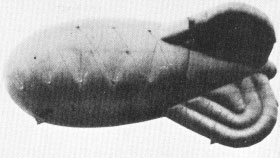 Click
for Site Directory
Click
for Site DirectoryUpdated August 2017 with new pictures of the propeller from the German bomber!
Updated December 2011 with new material from Shaun McGuire
966 Squadron claims first German Bomber with a Balloon Cable at Newport on September 13th 1940
Authority to establish a Balloon Barrage at Newport was given by Balloon Command for the purpose of protecting the Docks, Marshalling Yards, Iron Works, Munitions Works, Aluminium Works and Main Road Bridge The scale of the defence was originally laid down as 24 Balloons but later this was increased to 32 Balloons and finally 40. Preliminary reconnaissance was carried out by S/Ldr Harrison and F/Lt Stock on July 20th and 21st 1940 and further reconnaissance was made by F/Lt Bond and F/Lt Stock on July 24th 1940 and by S/Ldr Harrison and P/O Marsh on August 15th & 16th 1940 .On these various occasions sites and Headquarters were chosen; Full Air Staff and Administration reports were included in letters from HQ 32 (BB) Group to HQ Balloon Command dated 25th July 1940 Ref: 329/S.4025/4/AIR and August 17th 1940 Ref: S.4023/4/AIR.
Balloon Command instructed 33 (BB) Groups top form a squadron to be known as 966 Squadron and to consist of five flights of 8 crews each. S/Ldr J Jordan of 916 Squadron, No.6 Centre was appointed as Commanding Officer & F/Lt C. K. Horne* (See Footnote on This Officer below) of 916 Squadron No. 5 Centre as Squadron Leader in charge of Administration. Both these appointments were made by Balloon Command. Detailed Instructions as to the formation of the Squadron are included in a letter from HQ 33(BB) Group 15,16 and 17 Centres dated August 19th 1940 ref 33G/S/2827/5.
In brief this letter instructed:
No 15 Centre to provide 18 crews of 12 men.
No 16 Centre to provide 18 crews of 12 men.
No 17 Centre to provide 18 crews of 12 men.
The remainder of the squadron & Flight Personnel was detailed by the three Centres and by the Officer in charge of Records.
The following Officers were appointed by 33 (BB) Group:
F/Lt Admin........................F/Lt W. Maxfield 938 Squadron
"A" Flight..........................A/F/Lt T. Sample 15 Centre
P/O N.S. Todd 15 Centre
P/O Stokes 15 Centre
"B" Flight..........................A/F/Lt G. H. Brown 15 Centre
P/O M.N. Hardy 15 Centre
"C" Flight...........................A/F/Lt S.T. Carrier 16 Centre
P/O E. Shaw 16 Centre
P/O Mitchell 16 Centre
"D" Flight...........................A/F/Lt C.B North 17 Centre ( Click to see about Flight Lieutenant Cecil B. North )
P/O Hutchinson 17 Centre ( Click to see about Pilot Officer George Hutchinson )
"E" Flight............................A/F/Lt S Wilson 15 Centre
P/O G.F. Sharp 17 Centre
P/O A. E. Caen 16 Centre
966 Squadron was formed on the 23.8.40 and was made up of 3 units form 15 Centre ( Newcastle), 16 Centre (Sheffield) and 17 Centre ( Hull). An advance party of 58 Officers and airmen left for Cardiff from each centre on 23.8.40 and arrived same day. Meanwhile on the 24.8.40 back at Newcastle an inspection of "A" +"B" flights was made by AOC 33 BB Group. The following day 25.8.40 at Sheffield an inspection of "SHQ" +"C" flight was made by AOC 33 BB Group, the following day 26.8.40 at Hull an inspection of "D" flight was made by AOC 33 BB Group. A party left all 3 centres for Cardington with A/Fl/Lt CARRIER in charge, they were to collect 92 vehicles of various descriptions and head for Newport. On the 27.8.40 back at Sheffield an inspection of "E" flight was made by AOC 33 BB Group.
On the 27.8.40 the convoy left Cardington and arrived at Newport on the 28.8.40."E" flight arrived same day. The Squadron Headquarters had been previously occupied at 42 Fields Park Road on the 23.8.40 and taken over completely by 26.8.40. The airmen were accommodated in billets and tents were made available.
The first balloons were inflated and flown from sites 5, 7, 8, 9, 10, 11, 12, 13, 14, 15, 27, 28,29, 31, 32 on the 31.8.40, little did they know that they would make history for Balloon Command.
966 Squadron, No.14 Balloon Command was based at a place called Tredegar House at Tredegar Park, near Newport, Monmouthshire, South Wales. They have the honour of being the first Barrage Balloon Unit to bring down a German aircraft in WWII. In 1940 Newport was beginning to feel the war as 7,000 evacuee children arrived in the town, to be distributed around the county. During June, the town has 50 air raid alerts, the first of 480 to follow in the next 12 months. It was June 26th when the first bombs fell on the town, the bombs landed on St.Julians and Dewstow Street. The Squadron Operations Record Book shows that on Friday September 13th:
13.9.40 :"Balloons on sites 6,10, 20, 33, and 36 were deflated and lost".
But there is more to the deflation and loss of the balloon at site 10 as we can now find out.
An additional entry after the 14th September records:
13.9.40: Time 03.15 " HEINKEL III brought down by impact with cable on site 10 .Cable pulled right off storage drum although brakes were on. Plane also fouled cable on site 8 & finally crashed into a house in Stow Park & burst into flames. Three of the crew were killed & the Pilot was taken to the Royal Gwent Hospital with broken arm and a cut in head. Visit by AOC 31 (BB) GRoup and O.C. 14 Centre to all Headquarters & one site in each flight. In attendance S/LDR THACKER & P/O BACON (31 GROUP) and FL/L THOMAS ( 14 CENTRE).
14.9.40 Congratulatory telegram received from A.O.C. BALLOON COMMAND with reference to HEINKEL III.""
What had happened was a Heinkel 111P-2 bomber, identification number 1G+DS,(8 K.G.27) of Kampfgeshwader 27 near Paris had set off at 22.30 hrs on a routine bombing mission of Ellesmere Port in Cheshire. Within hours they had completed their operation without observing the results of their bombing and were heading back south to base. They were at 6,500 feet and passing over the Tredegar Park and hit the barrage balloon cable of one of the mobile Fordson winches scattered at various sites across the park. It had the misfortune to hit a second cable.
The aircraft, once it had hit the cables was doomed, since at this stage in the war, aircraft had no defence against the cable and it sliced into the wing and made the aircraft stall and swing around the cable wildly. The doomed aircraft began its final descent to earth. The crew of 966 Squadron included 528399 Sgt John Sanderson, the balloon crew knew they had scored a "hit" and raced across the park anticipating the arrival of a German aircraft on the green swathes of grass, however the plane by ill luck managed to stay aloft until it reached Newport. Realising that there was no hope the Pilot Oberleutnant Harry Wappler baled out. The three remaining crewmen were unable to bale out. The aircraft landed on Stow Park Avenue at the top of Stow Hill, at 3.15 a.m. hitting the rear ground floor of the house of Harold David Phillips and Marjorie Phillips family of No.32 Stow Park Avenue, filled with incendiary devices, it exploded on impact, causing a dense fire and acrid fumes. The son, Malcom Phillips aged 17 and daughter Myrtle aged 14, of the Phillips family had been made to sleep in the downstairs room for safety. Malcom ran upstairs to see if his parents were alright, and finding they were alive, he ran back downstairs and heroically tried to rescue his sister. But by this point she had been overcome with the fumes and smoke. In trying to rescue her he was overcome with the smoke and flames. Mr and Mrs Phillips escaped by knotting bed sheets together and sliding down to safety. Malcom was without doubt a fearless hero and deserves recognition now in 2008, almost 70 years since the event. I have no doubt that a similar incident today would result in no less than the George Medal being awarded. Both children were buried in the Jewish part of St.Woolos Cemetery.
They are both commemorated on the CWGC website. Follow these links to see:
Myrtle at: CWGC Myrtle Phillips and Malcom at: CWGC Malcom Phillips
Oberleutnant Harry Wappler probably had much easier egress from the plane than the other crewmen who might not have realised what had happened and were probably stuck in gun turrets as this particular aircraft had three sets of gun turrets below above and at the front. His parachute deployed correctly and he landed in Queen's Street, just off the Cardiff Road and near to the British Legion Club. His landing was affected by the parachute snagging in a tree and he suffered a broken right arm. He was quickly captured and disarmed although he realised there was no point in putting up much resistance. Such German crewmen who managed to bale out successfully, were always afraid of the possibility of vigilante action by the outraged British public, and being captured gave them some protection from the likelihood of a lynch mob. The town was shocked at the news as the family were well known in business in the area and ran a Tobacconist shop in Dock Street. A number of fuselage fragments were taken by some of the crew and in a time honoured ritual of servicemen, the flying boots of the airmen had their leather tongues removed as souvenirs.
Oberleutnant Wappler was on his 14th bombing mission that night since August and was imprisoned at a POW camp 198 at Bridgend, possibly Island Farm, and was involved with the biggest German escape in the UK during wartime when 67 prisoners tunnelled their way to freedom on the night of 10/11 March 1943. Harry Wappler it is believed succeeded in getting to Birmingham and it is suggested that he did manage to steal an aircraft only for it to run out of petrol in Norfolk before he could leave the UK and was recaptured. This is not confirmed at present. Research is ongoing into this aspect.
The three dead crew members, Navigator Unteroffizier Fritz Berndt age 25, Wireless Operator Oberfeldwebel Johannes Elster age 34 and Bombaimer Unteroffizier Herbert Okuneck age 25 were buried with military honours at St.Woolos Cemetery. Later they were disinterred and reburied at the German war Cemetery at Cannock Chase, Staffordshire.
Oberleutnant Wappler returned to Newport with his family Post War on several occasions and was reconciled with the Phillips family. He died in 1986.
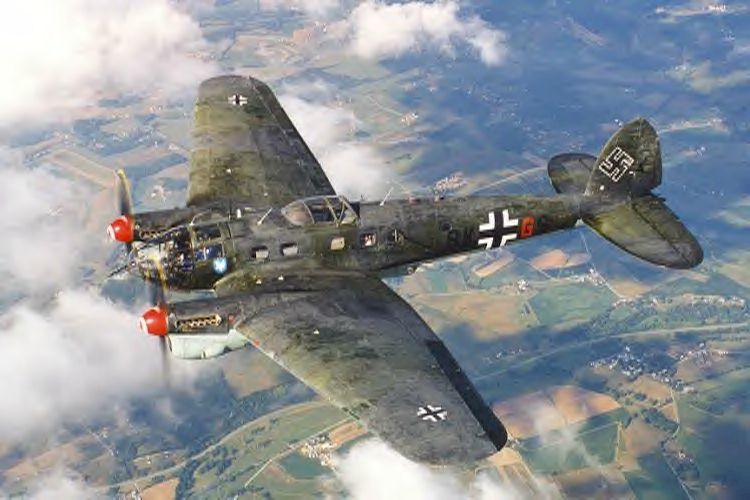
A Heinkel 111 Bomber
The newspapers ran the sad story of the crash and the street was full of local people who had come to see the war and its affects at close quarters.
The newspapers showed photographs of the crash site.
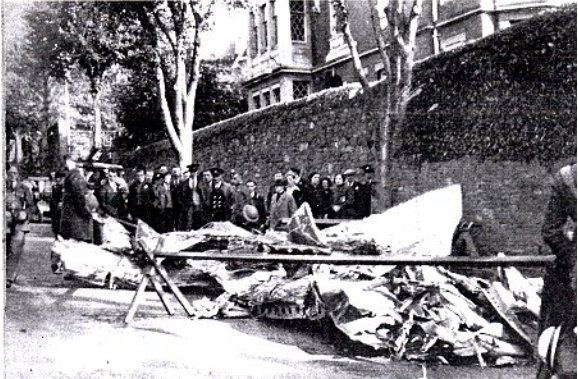
Above: The crash scene as pictured in the local paper in 1940

Above shows view today of wreckage site

Above: House today Courtesy of Shaun Maguire
Below: Map showing the house where Shaun McGuires' Family had a balloon land in the garden

Below: Map of Site and balloon site 10 and showing crash site superimposed on a 2006 map.
Above shows view today and the former Site 10's location at Tredegar Park
Above shows view today and the courtyard location at Tredegar Park
Above shows view today and the courtyard location at Tredegar Park
Above shows view today and the courtyard location at Tredegar Park. This is exactly same spot where John
Anderson is pictured astride his motorbike.
The graves of the three German airmen are shown below,
Photographs of the German headstones are courtesy of The War Graves Photographic Project
Elster, Johannes, 34, 13th September 1940, German Air Force (Luftwaffe), WOp., Oberfeldwebel, Airman, Cannock Chase German War Cemetery, Block 7, grave 294.
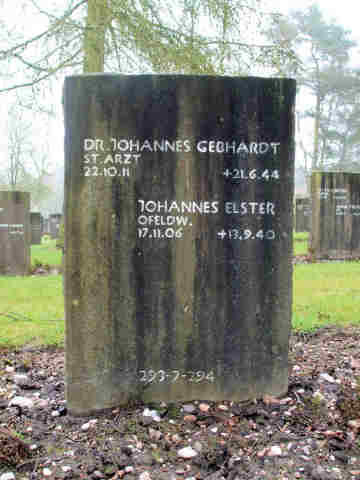
Berndt, Fritz, 24, 13th September 1940, German Air Force (Luftwaffe), Observer, 62693-23, Unteroffizier, Airman, Cannock Chase German War Cemetery, Block 7, grave 295 and
Okuneck, Herbert, 28, 13th September 1940, German Air Force (Luftwaffe), Bomb Master, 62693-95, Unteroffizier, Airman, Cannock Chase German War Cemetery, Block 7, grave 296. These two men share a headstone.
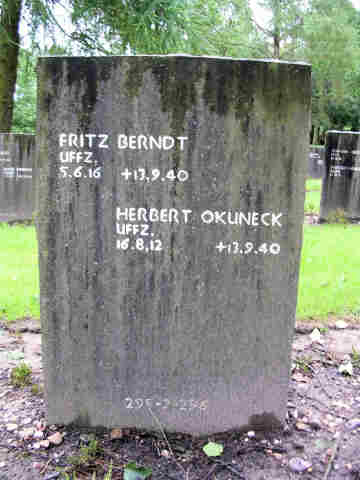
Many Thanks to Shaun McGuire for the photographs of the sites today.
Shaun has a superb website with this incident featured on it at:
In addition thank you for researching the story of this event in great detail
Below: Shaun has now used Google Earth to map out the balloon crash site.(Credit Google Earth)

Below: Shaun has now used Google Earth to map out the balloon landing site. (Credit Google Earth)
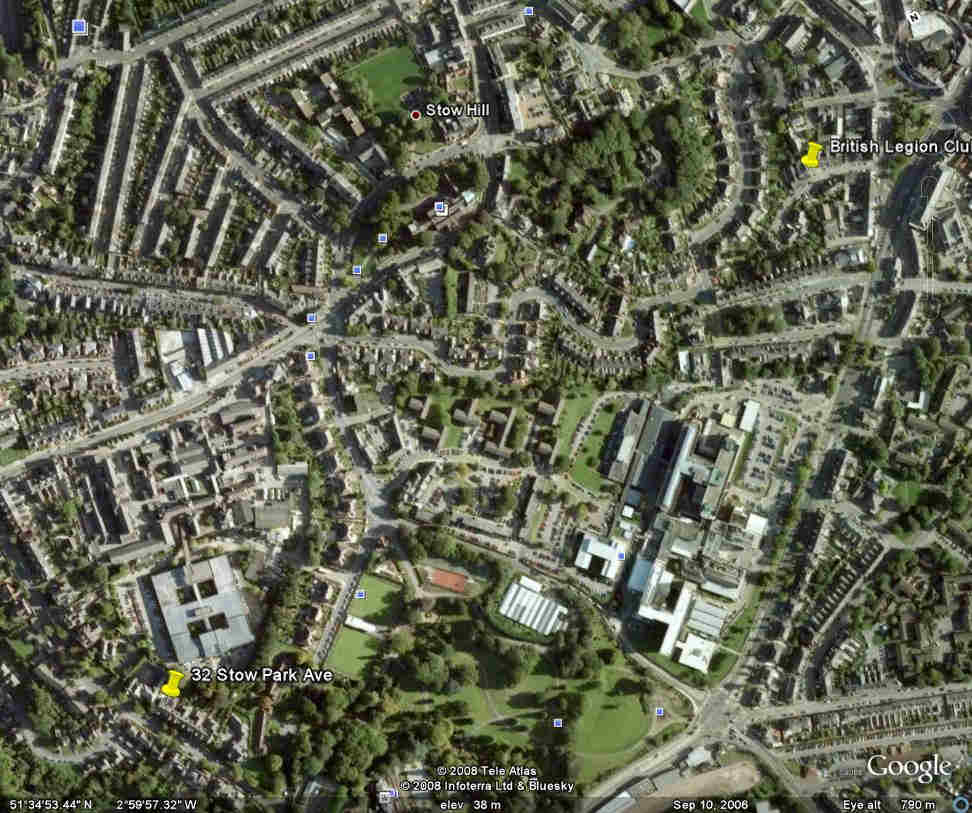

30th January 2008 Update :
Footnote on F/Lt C. K. Horne of 916 Squadron No. 5 Centre as Squadron Leader in charge of Administration at Newport.
I have just been told that this was 90766 Fl/ Lt Charles Kenneth Horne and he was the same man who was to come to fame throughout World war II and after as Kenneth Horne the radio star. He became famous for his "Round The Horne" shows. During WWII he was an Acting Pilot Officer and became confirmed as a Pilot Officer with 911 Sqdn (County of Warwick) effective 1st December 1939. On the 2nd July 1940 he became a Flying Officer with The Balloon Branch. 29th March 1943 he is now a Flight Lieutenant and is transferred to the Administrative and Special Duties Branch. 1st January 1944 finds him being promoted to Sqdn Leader (Tempy) Air Commodore (Tempy). 26th April 1944 finds him being promoted to Squadron Leader (War Subs). 9th July 1954 finds him placed on the Emergency List as he leaves the RAF and is given the retaining rank of Wing Commander. He was in charge of Balloons at Stanmore Middlesex at one point.
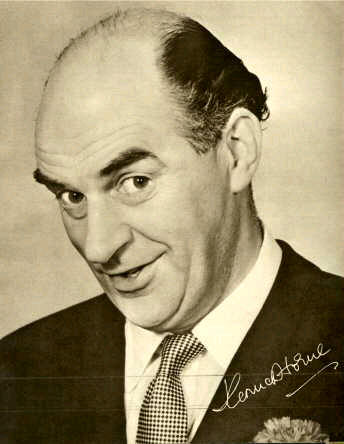
Kenneth Horne Post War
Does anyone recognise him and did anyone remember serving with him?
Additional Update January 2012.
The Records of No.14 Balloon Centre show that 969 Squadron was visited on the 2nd September 1940 by the Area Officer Commanding J.C. Quinnell D.F.C who "inspected the parade at 09.30 hours and subsequently addressed Officers and men. Air Commodore Quinnell referred to the enemy bomber which had been brought down at Newport the previous night by balloon cable, three enemy airmen killed and one injured."
In October 2015 I was approached by a family whose father had served as an officer in 966 Squadron at Newport. I was told that they had a Heinkel propeller and a gauge from a Heinkel. It transpired that these were removed from the Heinkel plane that crashed as "spoils of war".
I advised the owner that these were part an important part of the war history of Newport city and, if they were willing, they would be best gifted to the Newport Museum. They agreed to this and so I met them at Newport and witnessed the transfer of the heavy propeller, carried by two museum staff and other items through the streets of Newport to the museum.
21st October 2015: The Heinkel propeller is carried through the streets of Newport, 75 years before, it was helping to propel a Heinkel bomber
to it's target over the city.
At the museum the curator unwraps the propeller
The propeller shows clear signs of crash damage
The tip is bent and fractured
The gearing appears intact
The gauge taken from the cockpit of the Heinkel. It is interesting in that it has taken 75 years for these spoils of war
to surface but they add an important element to the story of 966 Squadron
Click for the John Sanderson Archive